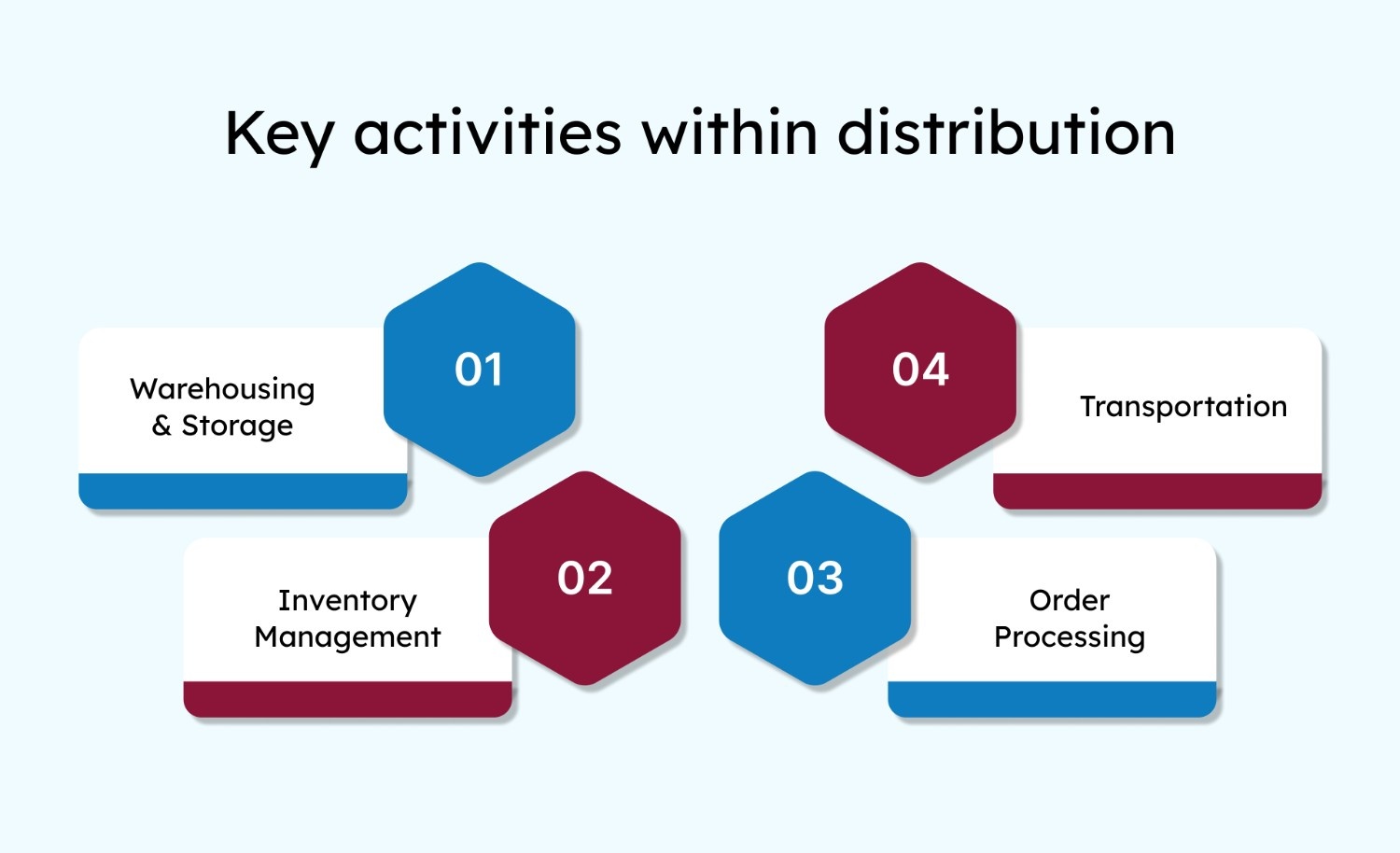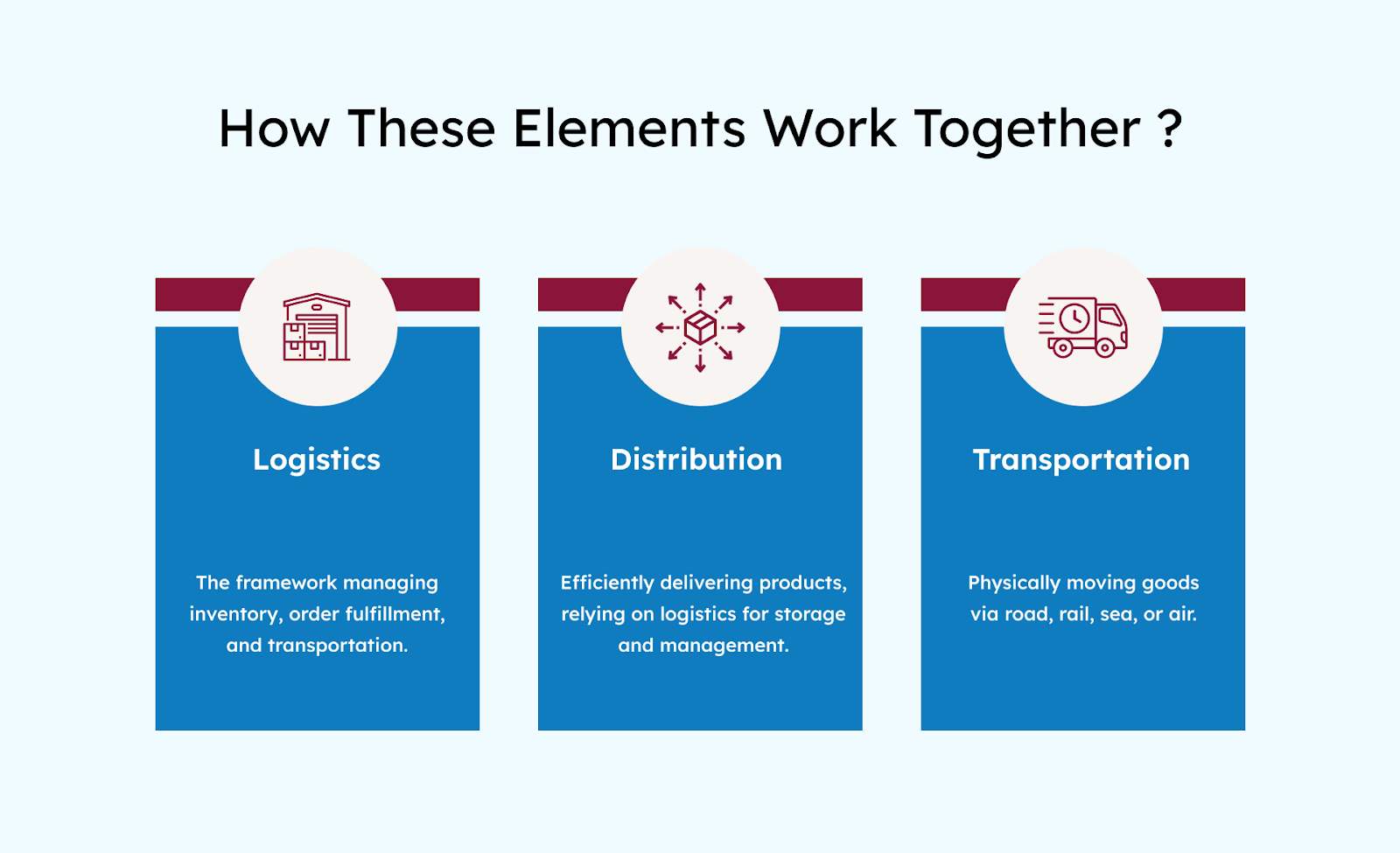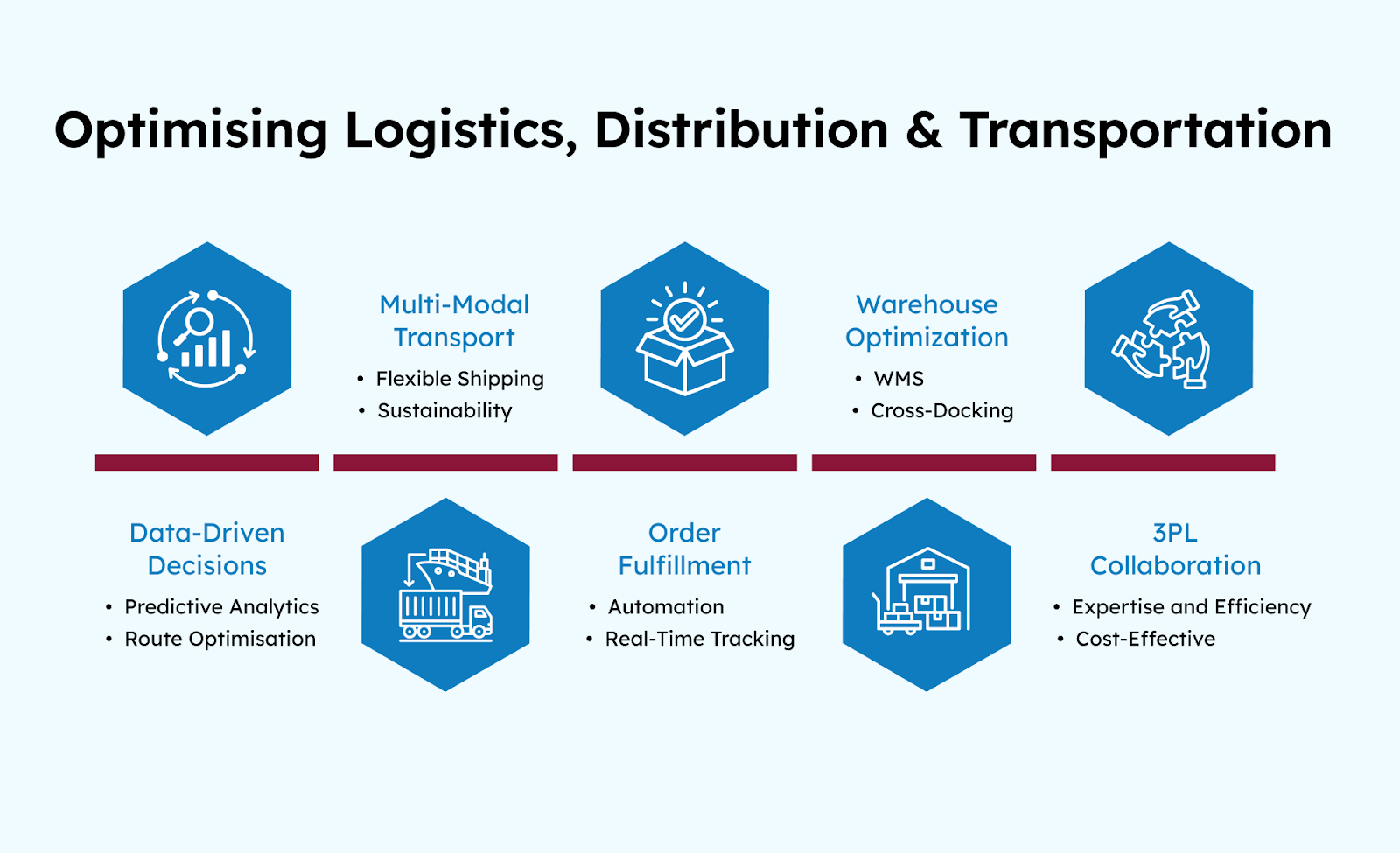Understanding Logistics, Distribution, and Transportation
.jpg)
If your supply chain isn’t running smoothly, your business isn’t either.
Logistics, distribution, and transportation are the invisible hands that move your products from the manufacturer to the customer. Often used interchangeably, these critical components are actually distinct yet interconnected aspects of supply chain management, each with its own set of responsibilities.
Without a clear understanding of how they interact, it’s easy to mismanage operations, increase costs, or even disappoint your customers. For businesses trying to scale or compete in a crowded market, this can result in missed opportunities and a slower path to growth.
In this blog, we’ll break down each component—logistics, distribution, and transportation—and show you how they work together to create a smoother, more cost-effective process.
What is Logistics?
Logistics is the meticulous process of planning, implementing, and controlling the efficient movement and storage of goods, services, and information across the supply chain from the point of origin to the point of consumption.
In 2025, the global logistics market was valued at approximately $11.23 trillion, with projections to reach around $23.14 trillion by 2034, registering a solid CAGR of 8.36%. Logistics ensures products are delivered in the right quantity, to the right location, at the right time, and in optimal condition.
Logistics includes these key components:
- Inventory Management: This involves overseeing the storage and distribution of goods to meet customer demand without overstocking or stockouts. Efficient inventory management minimises costs and maximises service levels.
- Order Fulfilment: The process of receiving an order and delivering it to the customer. This includes picking, packing, and shipping, with a focus on accuracy and timeliness.
- Warehousing: Storing goods in secure locations, ensuring they are accessible when needed. Modern warehouses often utilise technology for inventory tracking and management.
- Transportation: The physical movement of goods and materials through various modes, connecting different points across the supply chain.
- Information Flow: Managing data related to inventory levels, order status, and delivery schedules. Real-time information is crucial for making informed decisions and maintaining supply chain visibility.
In essence, logistics involves managing every part of the supply chain that handles product movement and storage, and it often includes both distribution and transportation under its umbrella.
Having explored the foundational role of logistics in the supply chain, let’s now zoom in on distribution, which is integral to getting products into the hands of the customer efficiently and on time.
What is Distribution?
Distribution is a subset of logistics that focuses specifically on delivering finished goods to wholesalers, retailers, or even end consumers. It encompasses the efficient movement of products from warehouses or production facilities through various channels to their final point of sale or consumption.
Here are the key activities within distribution:

- Warehousing and Storage: Specifically managing facilities (distribution centres or fulfilment centres) where finished goods are stored, consolidated, and prepared for outbound shipment. These hubs are critical for staging products to ensure immediate availability for customer orders and efficient market delivery.
- Inventory Management: This involves optimising the stock levels of finished products, specifically within distribution centres. The goal is to ensure immediate product availability for customer orders, prevent stockouts in the market, and facilitate rapid order fulfilment.
- Order Processing: The operational steps involved in picking, packing, and preparing specific customer orders for shipment from distribution centres. This stage focuses on accuracy, speed, and appropriate packaging for direct delivery to the end customer or retail channel.
- Transportation: The physical movement of finished goods, specifically from distribution centres or production sites to wholesalers, retailers, or directly to end consumers. This often involves selecting the most efficient modes and optimising routes for timely and cost-effective market delivery, including last-mile logistics.
An effective distribution strategy ensures goods are available in the right quantities and at the right time, providing customers with what they want when they need it without unnecessary delays.
While distribution ensures products are ready for delivery, transportation is the key mechanism that physically moves goods to their final destination. Let’s understand how this crucial step shapes the logistics process.
What is Transportation?
Transportation is a core component of both logistics and distribution, serving as the physical means to move products across different regions or internationally. It involves various methods of moving goods, including road, rail, sea, and air, each with its own advantages and limitations, depending on the type of product, destination, and delivery urgency.
Here are the different transportation modes:
- Road Transportation: Trucks and vans are ideal for short- to medium-distance deliveries, offering flexibility and door-to-door service. It’s the most versatile form of transportation, but it's subject to delays due to traffic and weather conditions. Road transport is often used for last-mile deliveries, where flexibility and speed are critical.
- Rail Transportation: Trains are more efficient for transporting large volumes of goods over long distances, especially for bulk commodities such as coal, steel, or agricultural products. Rail is cost-effective for long hauls and is less prone to delays caused by traffic.
- Sea Transport: Shipping by sea is crucial for international trade, especially for large and heavy shipments. Sea transport can carry massive amounts of cargo at a lower cost compared to air transport. However, it’s slower and more vulnerable to delays caused by weather conditions or port congestion.
- Air Transport: The fastest mode of transport, air freight is ideal for high-value, time-sensitive goods, such as electronics, pharmaceuticals, or perishable goods. However, air freight comes at a premium cost and is limited by size and weight restrictions.
Each mode has its strengths and weaknesses, and the best choice depends on the specific logistics needs of the business.
According to the International Transport Forum (ITF), global freight transportation volumes are expected to double by 2050, driven by the growth of e-commerce and international trade. Another report notes that rail and sea transport have the lowest carbon emissions per ton-mile, which makes them more environmentally friendly compared to road and air transport.
With a clear understanding of how logistics, distribution, and transportation function individually, it’s important to see how they smoothly integrate to optimise the entire supply chain process.
How Logistics, Distribution, and Transportation Work Together
While logistics, distribution, and transportation are separate concepts, they work interdependently in a smooth supply chain.

Let’s break down how they align:
- Logistics acts as the framework, ensuring that all pieces fit together, from inventory management to order fulfilment and transportation.
- Distribution focuses on delivering products efficiently, often relying on logistics to store and manage goods before they are dispatched.
- Transportation is the method by which goods are physically moved, whether it's through road, rail, sea, or air.
The success of your logistics operation depends on how well these components work together to optimise cost, speed, and customer satisfaction.
Now that we’ve seen how these elements come together, let’s explore the key metrics and technologies that can help you track and optimise your operations for better results.
Key Metrics and Technology Driving Integration
To better understand how logistics, distribution, and transportation work together, businesses should consider the following key performance metrics (KPIs):
- On-Time Delivery Rate (OTD): This metric measures the percentage of orders delivered on or before the promised date. High OTD rates are crucial for customer satisfaction and operational efficiency.
- Transportation Costs: Monitoring expenses related to freight, fuel, labour, and maintenance helps identify cost-saving opportunities and optimise spending.
- Inventory Turnover Rate: This ratio measures the frequency at which inventory is sold and replenished over a specified period. A higher turnover rate suggests efficient inventory management and demand forecasting.
- Order Accuracy: Ensuring that the correct products are delivered in the right quantities is vital for maintaining customer trust and reducing returns.
- Customer Satisfaction Score (CSAT): Gathering feedback through surveys and reviews provides insights into service quality and areas for improvement.
The integration of advanced technologies plays a pivotal role in optimising these KPIs:
- Artificial Intelligence (AI) and Machine Learning: AI algorithms analyse vast amounts of data to predict demand, optimise routes, and automate decision-making processes.
For instance, Amazon has integrated AI-driven warehouse robots and generative AI for advanced mapping tools, enhancing delivery efficiency and reducing emissions.
- Internet of Things (IoT): IoT devices, such as GPS trackers and RFID tags, provide real-time visibility into inventory and shipments, enabling proactive management and reducing delays.
- Blockchain Technology: Blockchain ensures transparency and security in supply chain transactions by providing an immutable ledger, which is particularly beneficial for tracking the origin of goods and ensuring compliance.
- Cloud Computing and Digital Twins: Cloud-based platforms facilitate data sharing and collaboration across the supply chain, while digital twins create virtual models of physical assets, allowing for simulation and optimisation of operations.
- Warehouse Management Systems (WMS): Modern WMS solutions automate inventory tracking, order fulfilment, and space utilisation, leading to improved accuracy and efficiency in distribution centres.
Ready to optimise your supply chain? Take control of your logistics, distribution, and transportation with WareOne’s expert solutions. Our advanced tools and smooth integration help you streamline operations, reduce costs, and boost efficiency.
Schedule a consultation with WareOne today and discover how we can support your growth.
Common Challenges in Logistics, Distribution, and Transportation
The logistics and transportation sectors are pivotal in ensuring the smooth flow of goods from suppliers to consumers. However, several challenges can impede efficiency and increase costs:
- Rising Fuel and Operational Costs: Fluctuating fuel prices and increased maintenance expenses can significantly strain logistics budgets. Companies often face the dilemma of balancing cost-efficiency with maintaining service quality.
- Labour Shortages: The logistics industry is facing a shortage of skilled workers, particularly in the areas of truck driving and warehouse operations. This scarcity leads to increased labour costs and challenges in meeting delivery demands.
- Supply Chain Disruptions: Unexpected events, such as natural disasters, geopolitical tensions, or pandemics, can disrupt supply chains, leading to delays and increased costs. For instance, recent global trade tensions have led to renewed uncertainty in logistics operations.
- Regulatory Compliance: Handling the complex web of regulations, especially when operating across international borders, can be resource-intensive. From customs documentation to environmental standards, staying compliant is crucial to avoid legal and financial penalties.
- Environmental Sustainability: The increasing pressure to reduce carbon footprints presents a significant challenge. Adopting eco-friendly practices often demands high initial investments and increased operational costs, requiring companies to balance sustainability goals with budget constraints and delivery efficiency.
- Inventory Management Challenges: Companies consistently grapple with the complexities of balancing inventory levels. The risks of overstocking (leading to high carrying costs and obsolescence), understocking (causing lost sales and customer dissatisfaction), and maintaining inventory accuracy are significant hurdles.
- Congestion and Infrastructure Limitations: Urban congestion and inadequate infrastructure can lead to delays in transportation. This is particularly evident in major ports and urban centres, where traffic bottlenecks impede the timely movement of goods.
Businesses in logistics and transportation are continually refining their strategies to overcome these challenges and optimise their operations for greater efficiency and cost savings.
Best Practices for Optimising Logistics, Distribution, and Transportation
Optimising logistics, distribution, and transportation is essential for streamlining operations, improving customer satisfaction, and reducing costs.

By implementing a few key best practices, businesses can enhance the efficiency of their supply chain, meet demand more effectively, and stay competitive in a rapidly changing market:
1. Embrace Data-Driven Decision Making
Data analytics is at the heart of any successful logistics operation. Businesses should adopt advanced tools that gather and analyse data from various touchpoints across their supply chain.
- Predictive Analytics: Use historical data to forecast demand fluctuations and identify potential supply chain bottlenecks before they occur. Predictive models help you plan for peak periods, reducing the chances of stockouts or excess inventory.
- Route Optimisation: Utilise real-time data and GPS tracking to continuously optimise transportation routes, thereby reducing fuel consumption, avoiding delays, and lowering transportation costs.
2. Adopt Multi-Modal Transportation
Using a combination of transportation methods—road, rail, sea, and air—ensures the most efficient and cost-effective delivery system, particularly for international shipments.
- Flexible Shipping: Use sea freight for large shipments and air freight for high-value or time-sensitive goods. Rail transport is ideal for bulk goods over long distances, while road transport offers flexibility for shorter distances or last-mile deliveries.
- Sustainability: Rail and sea transport generally have lower carbon footprints than road and air transport, contributing to more sustainable logistics practices.
3. Streamline Order Fulfilment Processes
Order fulfilment is at the core of customer satisfaction. Efficient picking, packing, and shipping are essential for meeting delivery promises.
- Automation: Implement warehouse automation to improve order-picking accuracy and speed. Automated systems reduce human error, increase throughput, and optimise space utilisation in warehouses.
- Real-Time Tracking: Enable customers to track their orders in real time. Offering visibility into delivery progress improves customer experience and reduces the volume of customer service inquiries.
4. Optimise Warehouse Management
Efficient warehouse management directly impacts distribution performance. Utilising technology for warehouse operations can significantly improve operational efficiency.
- Warehouse Management Systems (WMS): Invest in WMS for real-time tracking of inventory, order status, and stock location. A good WMS ensures accuracy and minimises delays in order fulfilment.
- Cross-Docking: Implement cross-docking, a strategy where goods are directly transferred from inbound to outbound transport without being stored. This reduces storage time and costs.
5. Collaborate with Third-Party Logistics (3PL) Providers
Outsourcing logistics, distribution, and transportation to third-party logistics (3PL) providers offers flexibility, expertise, and scalability without requiring significant capital investment.
- Expertise and Efficiency: 3PL providers specialise in logistics, meaning they have extensive experience managing warehousing, inventory, shipping, and customer service. By collaborating with their expertise, businesses can reduce the risk of delays, improve delivery times, and ensure compliance with international shipping regulations.
- Cost-Effective: Outsourcing eliminates the need to invest heavily in infrastructure, technology, and staffing. It allows businesses to avoid fixed costs, such as warehouse maintenance and employee salaries, and instead pay for services as needed, based on volume or seasonality.
To implement these best practices effectively, partnering with the right logistics provider is crucial. Let’s see how WareOne can support your business in optimising your logistics and distribution efforts.
How WareOne Can Help Optimise Your Logistics, Distribution, and Transportation
At WareOne, we simplify your entire logistics process, from warehousing and transportation to last-mile delivery. Our all-in-one platform is designed to effectively handle your business needs, making operations more efficient, cost-effective, and scalable.
- Integrated Logistics Solutions: WareOne offers a complete solution for logistics needs, including importer-of-record, customs, storage, and last-mile delivery. Combining these services under one platform reduces complexity, improves visibility, and ensures smoother operations with one invoice.
- Fast and Reliable Delivery: Our same-day and next-day delivery services across Qatar enable businesses to meet customer demands promptly. With real-time tracking labels, customers can monitor their shipments from start to finish, improving reliability and satisfaction.
- Hassle-Free Returns Handling: We simplify the returns process for your business, allowing customers to return products without delays. By streamlining returns handling, we help you maintain customer satisfaction and loyalty while reducing operational challenges.
- Comprehensive Analytics for Smarter Decisions: Track your inventory, delivery timelines, and cost-per-order with WareOne's real-time analytics. Our detailed reporting tools provide valuable insights to help you make data-driven decisions and optimise supply chain performance.
- Tailored Solutions for Small Businesses: WareOne offers flexible logistics solutions for small businesses, e-commerce platforms, and D2C brands. With no long-term commitments, we provide professional-level storage and delivery services that grow with your business needs.
- Enterprise-Level Solutions for Retailers: We cater to enterprise retailers with complex logistics needs, such as managing large SKUs, multi-node dispatch, and inventory rules. Our comprehensive platform integrates these functions into a streamlined system, enhancing efficiency and reducing operational complexity.
- Simplified Cross-Border Commerce: Expanding into the Qatar and GCC regions is made easy with WareOne's cross-border logistics solutions. We handle customs clearance and provide a single point of contact for all your international shipping needs, even if you don’t have an import license.
Conclusion
Logistics, distribution, and transportation are the three key components that power any supply chain. When optimised correctly, they work seamlessly together to ensure the timely, cost-effective delivery of goods to your customers. Understanding the differences between these modes and how they integrate is the first step to improving your logistics operations.
At WareOne, we understand the challenges of managing logistics operations. That’s why we offer a smooth, all-in-one platform to streamline your logistics, distribution, and transportation. From real-time tracking to hassle-free returns and enterprise-level solutions, WareOne is here to help your business thrive.
Ready to optimise your logistics and distribution? Partner with WareOne today and take your supply chain operations to the next level. Let us handle the complexities while you focus on growing your business. Reach out now to get started!